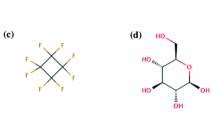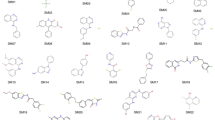Abstract
This paper reports the results of our attempt to predict hydration free energies on the SAMPL2 blind challenge dataset. We mostly examine the effects of the solute electrostatic component on the accuracy of the predictions. The usefulness of electronic polarization in predicting hydration free energies is assessed by comparing the Electronic Polarization from Internal Continuum model and the self consistent reaction field IEF-PCM to standard non-polarizable charge models such as RESP and AM1-BCC. We also determine an optimal restraint weight for Dielectric-RESP atomic charges fitting. Statistical analysis of the results could not distinguish the methods from one another. The smallest average unsigned error obtained is 1.9 ± 0.6 kcal/mol (95% confidence level). A class of outliers led us to investigate the importance of the solute–solvent instantaneous induction energy, a missing term in PB continuum models. We estimated values between −1.5 and −6 kcal/mol for a series of halo-benzenes which can explain why some predicted hydration energies of non-polar molecules significantly disagreed with experiment.










Similar content being viewed by others
References
Overview paper SAMPL2 referenceGuthrie, J. P. JCAM. 2010
Michel J, Tirado-Rives J, Jorgensen WL (2009) Energetics of displacing water molecules from protein binding sites: consequences for ligand optimization. J Am Chem Soc 131:15403–15411
Guthrie JP (2009) A blind challenge for computational solvation free energies: introduction and overview. J Phys Chem B 113:4501–4507
Honig B, Nicholls A (1995) Classical electrostatics in biology and chemistry. Science 268:1144–1149
Jeancharles A, Nicholls A, Sharp K, Honig B, Tempczyk A, Hendrickson TF, Still WC (1991) Electrostatic contributions to solvation energies—comparison of free-energy perturbation and continuum calculations. J Am Chem Soc 113:1454–1455
Sharp K, Jean-Charles A, Honig B (1992) A local dielectric-constant model for solvation free-energies which accounts for solute polarizability. J Phys Chem 96:3822–3828
Sitkoff D, Sharp KA, Honig B (1994) Accurate calculation of hydration free-energies using macroscopic solvent models. J Phys Chem 98:1978–1988
Feig M, Onufriev A, Lee MS, Im W, Case DA, Brooks CL (2004) Performance comparison of generalized born and Poisson methods in the calculation of electrostatic solvation energies for protein structures. J Comput Chem 25:265–284
Nicholls A, Wlodek S, Grant JA (2009) The SAMP1 solvation challenge: further lessons regarding the pitfalls of parametrization. J Phys Chem B 113:4521–4532
Nina M, Beglov D, Roux B (1997) Atomic radii for continuum electrostatics calculations based on molecular dynamics free energy simulations. J Phys Chem B 101:5239–5248
Nicholls A, Mobley DL, Guthrie JP, Chodera JD, Bayly CI, Cooper MD, Pande VS (2008) Predicting small-molecule solvation free energies: an informal blind test for computational chemistry. J Med Chem 51:769–779
Shivakumar D, Deng YQ, Roux B (2009) Computations of absolute solvation free energies of small molecules using explicit and implicit solvent model. J Chem Theory Comput 5:919–930
Truchon J-F, Nicholls A, Roux B, Iftimie RI, Bayly CI (2009) Integrated continuum dielectric approaches to treat molecular polarizability and the condensed phase: refractive index and implicit solvation. J Chem Theory Comput 5:1785–1802
OpenEye Scientific Software Inc (2007) Zap Toolkit, version 2.2.1; Santa Fe, NM, USA
Grant JA, Pickup BT, Nicholls A (2001) A smooth permittivity function for Poisson-Boltzmann solvation methods. J Comput Chem 22:608–640
Tan YH, Luo R (2007) Continuum treatment of electronic polarization effect. J Chem Phys 126:094103
Naim M, Bhat S, Rankin KN, Dennis S, Chowdhury SF, Siddiqi I, Drabik P, Sulea T, Bayly CI, Jakalian A, Purisima EO (2007) Solvated interaction energy (SIE) for scoring protein-ligand binding affinities. 1. Exploring the parameter space. J Chem Inf Model 47:122–133
Rankin KN, Sulea T, Purisima EO (2003) On the transferability of hydration-parametrized continuum electrostatics models to solvated binding calculations. J Comput Chem 24:954–962
Warshel A, Sharma PK, Kato M, Parson WW (2006) Modeling electrostatic effects in proteins. Biochimica et Biophysica Acta-Proteins Proteomics 1764:1647–1676
Schnieders MJ, Baker NA, Ren P, Ponder JW (2007) Polarizable atomic multipole solutes in a Poisson-Boltzmann continuum. J Chem Phys 126:124114
Weininger D (1990) Smiles.3. Depict—graphical depiction of chemical structures. J Chem Inf Model 30:237–243
Weininger D, Weininger A, Weininger JL (1989) Smiles.2. Algorithm for generation of unique smiles notation. J Chem Inf Model 29:97–101
Weininger D (1988) Smiles, a chemical language and information-system.1. Introduction to methodology and encoding rules. J Chem Inf Model 28:31–36
OpenEye Scientific Software Inc (2007) OMEGA, version 2.2.1; Santa Fe, NM, USA
Frisch MJ, Trucks GW, Schlegel HB, Scuseria GE, Robb MA, Cheeseman JR, Montgomery Jr JA, Vreven T, Kudin KN, Burant JC, Millam JM, Iyengar SS, Tomasi J, Barone V, Menucci B, Cossi M, Scalmani G, Rega N, Petersson GA, Nakatsuji H, Hada M, Ehara M, Toyota K, Fukuda R, Hasegawa J, Ishida M, Nakajima T, Honda Y, Kitao O, Nakai H, Klene M, Li X, Knox JE, Hratchian HP, Cross JB, Bakken V, Adamo C, Jaramillo J, Gomperts R, Stratmann RE, Yazyev O, Austin AJ, Cammi R, Pomelli C, Ochterski JW, Ayala PY, Morokuma K, Voth GA, Salvador P, Dannenberg JJ, Zakrzewski VG, Dapprich S, Daniels AD, Strain MC, Farkas O, Malick DK, Rabuck AD, Raghavachari K, Foresman JB, Ortiz JV, Cui Q, Baboul AG, Clifford S, Cioslowski J, Stefanov BB, Liu G, Liashenko A, Piskorz P, Komaromi I, Martin RL, Fox DJ, Keith T, Al-Laham MA, Peng CY, Nanayakkara A, Challacombe M, Gill PMW, Johnson B, Chen W, Wong MW, Gonzalez C, Pople JA (2004) Gaussian 03, Revision, version C.02; Wallingford CT, USA
Becke AD (1993) Density-functional thermochemistry.3. The role of exact exchange. J Chem Phys 98:5648–5652
Becke AD (1993) A new mixing of Hartree-Fock and local density-functional theories. J Chem Phys 98:1372–1377
Becke AD (1988) Density-functional exchange-energy approximation with correct asymptotic-behavior. Phys Rev A 38:3098–3100
Jakalian A, Jack DB, Bayly CI (2002) Fast, efficient generation of high-quality atomic charges. AM1-BCC model: II. Parameterization and validation. J Comput Chem 23:1623–1641
Jakalian A, Bush BL, Jack DB, Bayly CI (2000) Fast, efficient generation of high-quality atomic Charges. AM1-BCC model: I. Method. J Comput Chem 21:132–146
Singh UC, Kollman PA (1984) An approach to computing electrostatic charges for molecules. J Comput Chem 5:129–145
Truchon J-F, Nicholls A, Grant JA, Iftimie RI, Roux B, Bayly CI (2009) Extending the polarizable continuum dielectric model to account for electronic polarization in intermolecular interactions. J Comput Chem 31:811–824
Bayly CI, Cieplak P, Cornell WD, Kollman PA (1993) A well-behaved electrostatic potential based method using charge restraints for deriving atomic charges—the resp model. J Phys Chem 97:10269–10280
The restraints are in a.u. and correspond to the a parameter in equation 10 of reference 33. 2009
Bush BL, Bayly CI, Halgren TA (1999) Consensus bond-charge increments fitted to electrostatic potential or field of many compounds: application to MMFF94 training set. J Comput Chem 20:1495–1516
Woon DE, Dunning J (1993) Gaussian basis sets for use in correlated molecular calculations. III. The atoms aluminum through argon. J Chem Phys 98:1358–1371
Mennucci B, Cances E, Tomasi J (1997) Evaluation of solvent effects in isotropic and anisotropic dielectrics and in ionic solutions with a unified integral equation method: theoretical bases, computational implementation, and numerical applications. J Phys Chem B 101:10506–10517
Cances E, Mennucci B, Tomasi J (1997) A new integral equation formalism for the polarizable continuum model: theoretical background and applications to isotropic and anisotropic dielectrics. J Chem Phys 107:3032–3041
Mennucci B, Tomasi J (1997) Continuum solvation models: a new approach to the problem of solute’s charge distribution and cavity boundaries. J Chem Phys 106:5151–5158
Truchon J-F (2008) Modéliser la polarisation électronique par un continuum diélectrique intramoléculaire: Vers un champ de force polarisable pour la chimie bioorganique. Ph.D. Université de Montréal
Halgren TA (1999) MMFF VI. MMFF94 s option for energy minimization studies. J Comput Chem 20:720–729
Halgren TA (1999) MMFF VII. Characterization of MMFF94, MMFF94 s, and other widely available force fields for conformational energies and for intermolecular-interaction energies and geometries. J Comput Chem 20:730–748
Halgren TA (1996) Merck molecular force field.1. Basis, form, scope, parameterization, and performance of MMFF94. J Comput Chem 17:490–519
Halgren TA (1992) Representation of Vanderwaals (Vdw) interactions in molecular mechanics force-fields—potential form, combination rules, and Vdw parameters. J Am Chem Soc 114:7827–7843
Bondi A (1964) van der Waals volumes and radii. J Phys Chem 68:441–451
Jorgensen WL, Chandrasekhar J, Madura JD, Impey RW, Klein ML (1983) Comparison of simple potential functions for simulating liquid water. J Chem Phys 79:926–935
Wang JM, Wolf RM, Caldwell JW, Kollman PA, Case DA (2004) Development and testing of a general amber force field. J Comput Chem 25:1157–1174
Private communication with Dr. Christopher Bayly 2009
Rizzo RC, Aynechi T, Case DA, Kuntz ID (2006) Estimation of absolute free energies of hydration using continuum methods: accuracy of partial, charge models and optimization of nonpolar contributions. J Chem Theory Comput 2:128–139
Mobley DL, Dill KA, Chodera JD (2008) Treating entropy and conformational changes in implicit solvent simulations of small molecules. J Phys Chem B 112:938–946
Nicholls A (2007) OpenEye CUP8 conference, Santa FE, NM, February 26–28, 2007
Acknowledgments
The authors thank Dr. Christopher Bayly from Merck Frosst Canada for his guidance on the 3-stage RESP procedure, for the informatics tools he gratefully provided to us and for his comments on the manuscript.
Author information
Authors and Affiliations
Corresponding author
Electronic supplementary material
Below is the link to the electronic supplementary material.
Rights and permissions
About this article
Cite this article
Meunier, A., Truchon, JF. Predictions of hydration free energies from continuum solvent with solute polarizable models: the SAMPL2 blind challenge. J Comput Aided Mol Des 24, 361–372 (2010). https://doi.org/10.1007/s10822-010-9339-3
Received:
Accepted:
Published:
Issue Date:
DOI: https://doi.org/10.1007/s10822-010-9339-3




